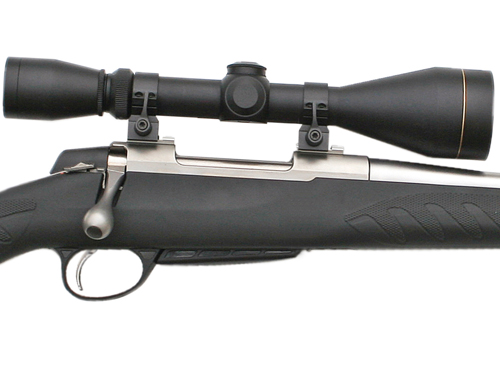Sako A7 rifle
The Sako A7 incorporates the barrelled action from a Sako rifle, and adds to it Tikka' s stock styling, with a few twists, such as the soft-touch synthetic stock finish, standard Weaver scope mounts and a new magazine that can be loaded into the rifle from the top or separately.

Sako A7 rifle
Overall Rating: 89%
Manufacturer: Sako
Pros: The magazine offers great versatility when loading. Great accuracy
Price as reviewed: £1,280
I’ve always thought it would be good to have a rifle that combines the standard and price of the Tikka T3, with the advanced features of the Sako range. That is just what the Sako A7 does.
It incorporates the barrelled action from a Sako rifle, and adds to it Tikka’s stock styling, with a few twists, such as the soft-touch synthetic stock finish, standard Weaver scope mounts and a new magazine that can be loaded into the rifle from the top or separately.

The 20in barrel version on test comes threaded and is available in a variety of cartridges, from .22-250 to .300 Win Mag.
Two action lengths
For maximum corrosion resistance you can choose the Sako A7 in stainless steel. There is also a blued finish coated to repel bad weather and wear and tear.
The A7 is available with two action lengths. A short action for .22-250 to .338 Federal loads as well as both .270 Short Magnums and .300 Win Short Magnums. A medium action is available for .25-06 to .30-06 loads in addition to the Magnums, such as 7mm Rem Mag and 300 Win Mag.
The rifle I tested had the .243 short action, which uses Sako’s three-lugged bolt locking system. This allows a short bolt lift to open. The bolt operates smoothly with a straight profiled handle.
A single extractor grips the spent case and the plunger ejects it forcefully.

On the Sako A7 a separate recoil lug is sited in the stock system. Although this works well I prefer the lug attached to the receiver ring.
Sako has opted for the Weaver picatinny mounting system to make the scope mounting options more universal. So observers will note the lack of trademark tapered dovetails.
It is a beneficial move as it allows a wider range of mounts to be fitted. OptiLocks are also available for Weaver mounts.
Barrel and sights
The Sako A7 is available with Sporter profile barrels.

The Magnum calibres have a Metric M15x1 thread, while the standard calibres have the M14x1 thread.
The barrels are made using the traditional method of cold-hammer forging, and the rifling twist on this .243 rifle was one-in-10in, which allowed the use of all the bullet weights available.
The stainless steel finish is muted to reduce reflections, and it is free-floated along the length of the fore-end stock section, with a small support midway along.
Accuracy and load
I shot a variety of bullet weights in the factory loads because the .243 can be used for vermin as well as deer.

The Winchester 95-gr Ballistic Silvertips shot tight, 1in three-shot groups at 2,864fps for 1,730ft/lb energy just legal for deer in England.
The Norma and RWS loads were equally good at 2,783fps and 2,791fps, generating 1,720ft/lb and 1,730ft/lb respectively.
The RWS shot groups of just under 1in at 100 yards. This is reasonable for a Sporter-weight barrel.
Of the reloads, a good fox load would be the Hornady 75-gr V-Max travelling at 3,208fps, propelled by 45 grains of H4350 powder.
These grouped at just under 1in. The Nosler 95-gr Ballistic Tip is a good fox or deer bullet, and 44 grains of Reloder RL 19 powder gave 2,882fps and 1,756ft/lb of energy for an impressive 0.85in grouping.

The Sierra 100-gr Game King was not far behind at 2,796fps, but the best performance was from the Nosler 100-gr Ballistic Tip bullet, which travelled at 2,845fps, producing 1,798ft/lb and excellent groups of 0.85in at 100 yards.
Stock
The stock on the rifle is impressive. It feels rigid and solid, which adds to success with handling and accuracy. It is also comfortable to use. Although there is no chequering, there is moulding in the raised finger ridges and a dimond pattern helps with grip. 
The whole surface is tactile, thanks to a soft-touch coating which is also practical. Stainless steel sling-swivel studs and a 1in black rubber recoil pad finish it off.
Trigger, magazine and safety
Sako are renowned for the quality of their triggers and this one didn’t disappoint either.
You can adjust the trigger with a screw in the trigger housing (this is accessed when the stock is removed) with a pull-weight range from 2lb to 4lb.
On the model I reviewed the factory setting was 2.85lb which worked well for me.
Alternatively a set-trigger unit can be fitted instead, with a superb lightweight trigger pull of 7oz to 9oz.
The safety is the excellent Sako lever type, with an additional plunger to allow the bolt to operate to load or unload the A7 with the safety on. This is another feature I appreciated.
Best of all is the newly designed magazine which offers great versatility when loading.
To detach you gently press it in at the front end while operating the release lever. This stops the magazine popping out by mistake.
The .243 on test held three rounds stacked in a single column.
The magazine can be loaded through the action while the magazine remains in place, which is great if you want a fast top-up and do not have a spare magazine.

Conclusion
The Sako A7 handles like a Tikka, but it has a better stock. The action is true to Sako’s traditions, but the addition of a Weaver mount allows a universal fit for a variety of scope mounts.
The magazine’s dual-action release mechanism is a nice feature but the accuracy impresses most.
Take a look at the velocity figure.

Verdict
A good looking rifle that handles well








